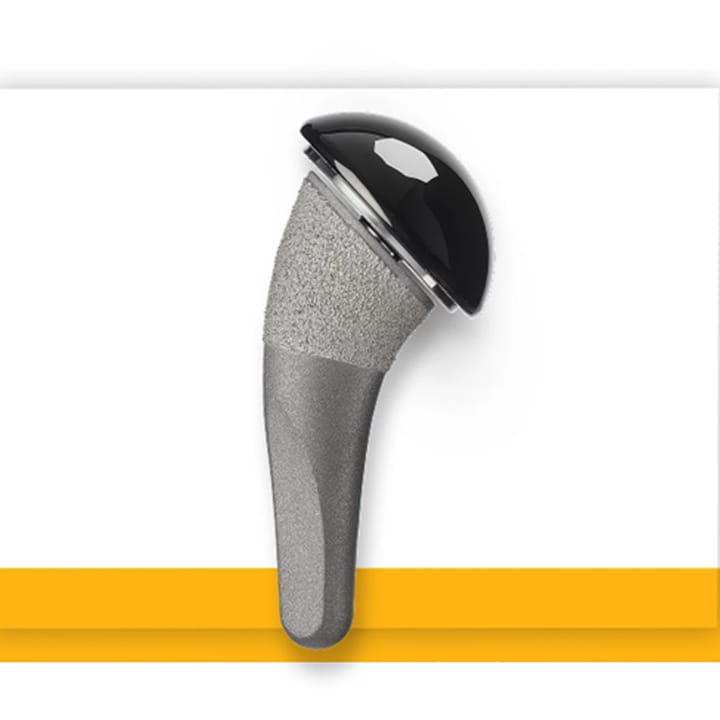 Julie Bishop, MD, clinical professor in the Department of Orthopaedics at The Ohio State University College of Medicine, is changing the approach for treating young patients with severe arthritis using a new Food and Drug Administration (FDA)-approved humeral head made of pyrocarbon for shoulder hemiarthroplasty.
Julie Bishop, MD, clinical professor in the Department of Orthopaedics at The Ohio State University College of Medicine, is changing the approach for treating young patients with severe arthritis using a new Food and Drug Administration (FDA)-approved humeral head made of pyrocarbon for shoulder hemiarthroplasty.
Shoulder joint replacement surgery has never been a great solution for these young patients. That’s because the titanium traditionally used for humeral head replacements is extremely heavy and wears out the shoulder socket, necessitating future surgeries including complete shoulder replacements. The titanium implant puts higher force on the glenoid and leads to a breakdown of cartilage. For young patients, these repetitive surgeries can have lasting impacts, from ending careers in sports to limiting activities of daily life.
“Young people with arthritis can be scary, especially since the previous hemiarthroplasty option was not a great solution for them,” Dr. Bishop says. “Ohio State has access to the latest technology and techniques to treat this unique patient population. We’re looking forward to serving patients across the Midwest as more physicians learn about this treatment option.”
New material, better outcomes
Compared to titanium, pyrocarbon is a more advanced material, has surface properties that are similar to bone and better simulate the humeral head sitting in the socket. It’s lightweight and more protective of the glenoid in the long term, which reduces the need for more shoulder surgeries.
Surgeons have been using this material for orthopedic procedures internationally since the 1990s, with the first use in shoulder surgeries in 2013. Medical technology company Stryker pioneered the device, called the Tornier Pyrocarbon Humeral Head, which received FDA approval in March 2023 after several years of clinical trials.
For experienced surgeons, the steps for implanting this device are the same, though according to Dr. Bishop, the device itself feels different than the other humeral implants she’s used.
“After seeing metallic titanium implants your whole career, this new implant feels like a feather from a surgeon’s perspective,” Dr. Bishop says. “It’s really cool.”
Because this material is newly approved domestically, there are no long-term results for pyrocarbon implants reported in the United States yet. However, in the case of shoulder hemiarthroplasty, pyrocarbon internationally has demonstrated longevity without impacting the glenoid. In fact, some early international studies hypothesize the formation of a neuromembrane around the humeral head acts like cartilage and reduces wear on the socket.
“We’ve been hearing about pyrocarbon for years, so having a new FDA-approved device is an exciting prospect for orthopedics,” Dr. Bishop says. “It wasn’t hard to bring it to Ohio State. It’s a perfectly safe material and, at this point, there is nothing experimental about it.”
Taking the latest care to our communities
The Ohio State University Wexner Medical Center has been on the leading edge of taking this new device to the Midwest. Dr. Bishop performed the 14th pyrocarbon shoulder hemiarthroplasty nationally and the first in Ohio.
“As a tertiary academic referral center, Ohio State doesn’t delay bringing the latest in innovative care to patients,” Dr. Bishop says. “We are uniquely equipped because we research, talk with and treat this patient population more than the average surgeon. We know all the options and who is and is not a candidate for these new technologies and techniques.”
Looking ahead, pyrocarbon offers similar hope for other medical devices. This material will likely be expanded to other joint replacements beyond the shoulder in the coming years.
For now, pyrocarbon is giving young patients hope for continued activity with fewer surgeries.
“It’s important for young people who play sports and have arthritis at a young age to know they have options,” Dr. Bishop says. “This surgery is going to allow young arthritis patients to get back to their sports without pain. Because of this new material, they can keep going without the need for more surgery.”
